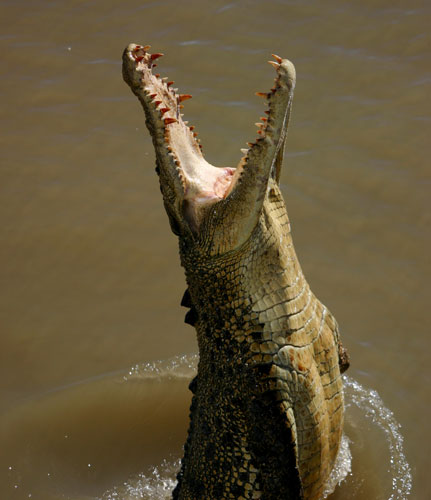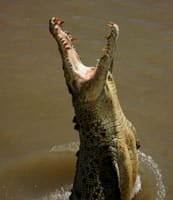Florida researchers study bite forces and pressures of the largest reptiles.
In Greg Erickson's lab at Florida State University, crocodiles and alligators are everywhere. Skeletal snouts and toothy grins adorn window ledges and tables — all donated specimens that are scrutinized by researchers and students alike. Biology professor Erickson and his colleagues have been pondering a particularly painful-sounding question: how hard do alligators and crocodiles bite?
More Than a Decade of Work
The answer is with a force of up to 3,700 pounds in the case of a 17-foot saltwater crocodile, whose tooth pressures are equivalent to a staggering 350,000 pounds per square inch. That's the highest bite force ever recorded — beating a 2,980 pound measurement for a 13-foot wild American alligator measured in Erickson's lab seven years ago. The researchers estimate that the largest-known extinct crocodilians, measuring 35-40 feet long, would have had bite forces as high as 23,100 pounds.

Photo credit: Thinkstock.
Although the appearance of their snouts has differed significantly in some cases, the body shape of crocodilians has remained remarkably constant throughout their evolutionary history.
Funded by the National Geographic Society and the FSU College of Arts and Sciences, their study considered the bite force and tooth pressure of every single living species of crocodilian. It took more than a decade to complete this work and required a wily team of croc handlers and statisticians, as well as an army of undergraduate and graduate students.
Erickson describes crocodilian bite-force testing as being a bit like dragon slaying by committee. "Our work required a team effort," he says. As a result of this work, the team has gained a new understanding about how these animals became so successful and a better appreciation about the remarkable biology of living crocodiles and alligators.
The study's findings are so unique that Erickson's team has even been contacted by staff at the Guinness Book of World Records inquiring about the data! They have also developed new methods for testing bite forces.
Obtaining the Data
Since starting the study, Erickson and his team have roped 83 adult crocodilians in the United States and Australia, strapped them down, placed a bite-force device between their back teeth and recorded the bite force. An engineering calculation was then used to estimate the force generated simultaneously by the teeth nearest the front of the jaws. The team molded the teeth with dentist's dental putty, made casts and figured out the contact areas.
"I have to admit, the first time I placed our meter into the maw of an adult crocodile, I was nervous," says Erickson. “It was all over in the blink of an eye. When it struck, it nearly wrested my grip from the handle. The noise of the jaws coming together was like a gunshot. The power of the animal was astounding, and the violence of the event frightening."
A similar design
Crocodilian species have ranged over time from 3-40 feet long, and they have showed concurrent major changes in their jaw shape and tooth form, but their body outline has remained largely unchanged.
"We set out to answer how this anatomical variance related to their ability to generate bite force and pressures for feeding in the different forms and thus how they have been so successful," explains Erickson. "The bite force over the contact area is the pressure, which is more pertinent to feeding performance. Ultimately, it tells us just what they were doing with those prodigious bite forces."
And, he added, gators and crocs have comparable maximal bite-force capacity when measured pound for pound. They basically all have the same musculoskeletal design, just different snouts and teeth. "It is analogous to putting different attachments on a weed eater — grass cutter, brush cutter, tree trimmer, they all have the same type of engine," Erickson says. "There are bigger and smaller engines, with higher and lower horsepower, but they all have the same attachments."
His research team is now using the study's data to explore bite-force and tooth-pressure performance in fossil forms. They are building the world's most sophisticated models for extinct crocodiles and dinosaurs based on these findings, as well as continuing to study the overall significance of the form of the crocodilian snout.
Reference: Erickson GM, Gignac PM, Steppan SJ, Lappin AK, Vliet KA, et al. (2012) Insights into the Ecology and Evolutionary Success of Crocodilians Revealed through Bite-Force and Tooth-Pressure Experimentation. PLoS ONE 7(3): e31781. doi:10.1371/journal.pone.0031781



